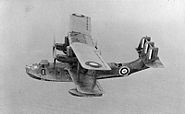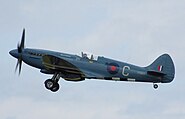- "RAF Seletar" & "Seletar Airbase/Airfield" redirects here.
| Seletar Airport 实里达机场 செலட்டர் வான்முகம் | |||
|---|---|---|---|
| IATA: XSP – ICAO: WSSL | |||
| Summary | |||
| Airport type | Civilian public usage | ||
| Owner | Government of Singapore | ||
| Operator | Changi Airport Group | ||
| Serves | Singapore | ||
| Location | Seletar | ||
| Elevation AMSL | 11 m / 36 ft | ||
| Coordinates | 01°25′01″N 103°52′04″E / 1.41694°N 103.86778°E | ||
| Website | |||
| Runways | |||
| Direction | Length | Surface | |
| m | ft | ||
| 03/21 | 1,836 | 6,023 | Asphalt |
Seletar Airport (IATA: XSP, ICAO: WSSL) is a civilian airport located at Seletar, in the northeastern region of Singapore, and is managed by the Changi Airport Group. Originally, the airport was completed in 1928 as a flying Royal Air Force station (RAF Seletar) and was also Singapore's first international airport.
There had been a proposal to extend its runway to 2,000 metres (6,600 ft), so as to be able to receive the Boeing 737 used by many budget airlines. However, after considerations by the Singapore Government and the CAAS, they decided to build a Budget Terminal in Singapore Changi Airport instead.
History[]
RAF Seletar[]
RAF Seletar Crest Badge
RAF Seletar was a Royal Air Force station in Singapore between 1928 and 1971. Plans for establishing an airfield, flying boat and naval base in Singapore were first agreed by the RAF in 1921. In 1923, two sites in the northern region of the island were approved. The first planes to arrive at the base were four Supermarine Southampton seaplanes on 28 February 1928.
RAF Seletar served as a civil airport from 1930 before the opening of Singapore's first civil airport at Kallang on 12 June 1937 (to the late 1940s).
The air base was briefly host to Amy Johnson during May 1930 on her UK - Australia flight in her Gipsy Moth named 'Jason'.
World War II[]
With the threat of war in the area, the RAF started building up their forces in the Far East in the late 1930s and early 1940s. Seletar airfield was the target of carpet bombing when Japanese navy bombers conducted the first air raid on Singapore, sometime after their ground forces invaded Kota Bahru. It was abandoned when the Japanese took Johore Bahru, which brought their artillery in range of the airfield.
When the Japanese launched their invasion of Malaya and Singapore, Seletar housed the RAF’s 205 Sqn with PBY Catalina flying boats and 36 and 100 Sqns with obsolete Vickers Vildebeest torpedo bombers (including five Fairey Albacores acquired by 36 Sqn to supplement its Vildebeests), along with 151 Maintenance Unit. These units stayed until Jan-Feb 1942, soon before the surrender to the invading Japanese.[1]
During the Japanese occupation, Seletar as was in the case of Sembawang came under the Imperial Japanese Navy Air Service while Tengah fell under the jurisdiction of the Imperial Japanese Army Air Force. From 1942 through 1945, a number of IJN squadrons were based or transited through Seletar mainly, for training. Among the units known to be based at Seletar during this time were 936 Kokutai (B5N Kate, D3A Val and E13A1 Jake), 381 Kokutai (A6M Zero and J2M Raiden). The 601 Kokutai was also stationed there for training in early before its destruction on board Japanese aircraft carriers during the Battle of Philippine Sea (Marianas Turkey Shoot) in June. Seletar’s present runway was built during the Japanese Occupation.
Post-World War II[]

RAF officers watch as Vice Admiral Kogure appends his signature to the document marking the formal takeover of Seletar airfield from the Japanese, 8 September 1945.
After World War II, the base went back to the RAF and, in the late 1940s and 1950s, the base was heavily involved in the Malayan Emergency, with Beaufighters, Spitfires and Mosquitos based there while operating against Malayan Communist insurgents. Among the many squadrons based there during this time were Nos 60, 81 and 205 Sqns of the RAF.[2]
During the 1960s, RAF Seletar was home base to No's 103 and 110 Squadrons, both of which were equipped with Westland Whirlwind Mk 10 helicopters and to 34 Squadron, which was equipped with Blackburn Beverleys. All three Squadrons (among several others) were involved with support of operations in North Borneo during the Indonesia-Malaysia confrontation. From June 1962, 66 Squadron (led by Sqn Leader Gray) with their Bristol 192 Belvedere helicopters were also based at Seletar, and were sent on frequent tours and detachments to Kuching, Brunei, Labuan and Butterworth as part of the Borneo hearts and minds campaign (the squadron was later disbanded in March 1969).[2] The helicopter squadrons provided a search and rescue service for the Singapore area. The station was also, at that time, home to 209 Squadron, equipped with Single and Twin Pioneer aircraft. 65 Squadron based at Seletar operated Bloodhound Mk II surface-to-air missiles as anti-aircraft defence from 1 January 1964 until the squadron was disbanded on 30 March 1970 with the equipment and role handed over to 170 Squadron, Republic of Singapore Air Force.[2] Auster aircraft were flown during the Emergency and Confrontation periods in troop/enemy spotting patrols.
In December 1966, three Andover CC Mk1 arrived to replace the ageing Vickers Valetta C1 aircraft of 52 Sqn. 52 Squadron was later reformed in March 1967 after the arrival of a further three aircraft. By now, Confrontation had finished and with no purpose the squadron moved to Changi in 1968 before being disbanded in January 1970.[2]
British Pullout[]
The RAF station closed at the end of March 1971 (see East of Suez) and Seletar was handed over to the Singapore Air Defence Command (SADC, which became the Republic of Singapore Air Force (RSAF) later) by 1973, after the British pullout.
Among Seletar’s claim to fame was that several classic aircraft type flew their last RAF Operational sorties from there including the Short Singapore flying boat (Mk.III K6912 of No. 205 Squadron RAF 14 October 1941, aircraft transferred to No. 5 Squadron RNZAF),[3] Supermarine Spitfire (PR.XIX PS888 of 81 Sqn 1954), De Havilland Mosquito (PR.34 RG314 of 81 Sqn 1955), Short Sunderland flying boat (GR.5 ML797 "P" of 205 Sqn, 15 May 1959) and Bristol Beaufighter (TT.X RD761 Station Flight 1960). The Short Sunderland flying boats started in RAF service from Seletar on 22 June 1938 with 230 Sqn,[4] a sister squadron of 205 Sqn.
Seletar Airbase[]
The formative years of the SADC (later the RSAF) was established at Seletar Airbase in September 1968, with the setting up of the Flying Training School (FTS) utilising three Cessna 172G/H on loan from the Singapore Flying Club. The subsequent arrival of eight new Cessna 172Ks in May 1969, took over the duty from the former and contributed to the increase of training tempo for more selected trainees to participate in the basic flight-training course.
Current operations[]
Seletar Airport now operates as a general aviation airport, mainly for chartered flights and training purposes. Currently, the airport is open 24 hours a day, has a single runway with 27 aircraft stands, has 100 square metres of warehouse space and can handle 840 tons of freight per day. In 1998, the airport recorded receiving a total of 7,945 scheduled flights, handled 23,919 passengers and 6,025 tons of cargo.
The Republic of Singapore Flying Club, Seletar Flying Club and Singapore Flying College are situated at Seletar Airport. The Singapore Flying College also conducts its flying training at Jandakot Airport in Perth, Western Australia and at Sunshine Coast Airport in Maroochydore, Queensland. Another prominent flying school is the Singapore Youth Flying Club, which has its headquarters built on western side of the airport's runway. Completed in June 2001, the clubhouse also has its own parking bays for its fleet of Piper Warrior II, CT-4E and Diamond DA40. Also, the rotary training unit of Republic Singapore Air Force - 124 Squadron, has a training detachment at the civilian airport although it is normally headquartered at Sembawang Air Base.
Previously Berjaya Air operated scheduled flights to Tioman and Redang. The Berjaya Air service ended on 31 October 2010 and relocated to Changi Airport.
In 2007, JTC Corporation announced the plan to upgrade the Seletar Airport to support the upcoming Seletar Aerospace Park. The plan included lengthening the airport's runway to 1,800 metres and the upgrading of its avionics systems to allow bigger aircraft to land and take off.[5] Changi Airport Group took over the management of the airport from the Civil Aviation Authority of Singapore on 1 July 2009.[6]
Airlines and destinations[]
| Airline | Destination |
|---|---|
| Airmark Aviation | Charter : Batam |
Photo gallery[]
See also[]
- Singapore strategy
- British Far East Command
- Far East Air Force (Royal Air Force)
- Far East Strategic Reserve
- Former overseas RAF bases
- Battle of Singapore
- Malayan Emergency
- Indonesia–Malaysia confrontation
- Seletar Aerospace Park
- Woodbridge Hospital
References[]
- Notes
- ↑ Shores et al. 1992, p. 146.
- ↑ 2.0 2.1 2.2 2.3 Jefford 2001, pp. 48-49.
- ↑ "New Zealand Military Aircraft Serial Numbers - Short Singapore Mk III". www.adf-serials.com. http://www.adf-serials.com/nz-serials/K6912.shtml.
- ↑ Rawlings 1969, p. 242.
- ↑ Karamjit Kaur (27 June 2007). "Seletar gets ready for makeover as aerospace hub". The Straits Times.
- ↑ Seletar Airport at Changi Airport Group
- Bibliography
- Wing Commander C. G. Jefford (2001). RAF Squadrons: A Comprehensive Record of the Movement and Equipment of All RAF Squadrons and Their Antecedents Since 1912. Shrewsbury, Shropshire, UK: Airlife Publishing, 1988. ISBN 978-1-84037-141-3.
- Rawlings, J.D.R. "History of 230 Squadron". Air Pictorial, July 1969. Vol. 31 No.7. pp. 242–244.
- Shores, Christopher, Brian Cull and Yasuho Izawa. Bloody Shambles: Volume One: The Drift to War to the Fall of Singapore. London: Grub Street, 1992. ISBN 0-948817-50-X.
External links[]
- Seletar Airport at Changi Airport Group
- History of RAF
- Crest badge and Information of RAF Seletar
- Seletar Air Force Association
- Review of book: "SELETAR, Crowning Glory - The History of the RAF in Singapore"
- Airport information for WSSL at World Aero Data. Data current as of October 2006.
The original article can be found at Seletar Airport and the edit history here.









